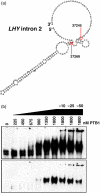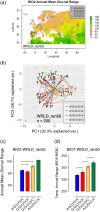Global spatial analysis of Arabidopsis natural variants implicates 5'UTR splicing of LATE ELONGATED HYPOCOTYL in responses to temperature
- PMID: 29520807
- PMCID: PMC6033021
- DOI: 10.1111/pce.13188
Global spatial analysis of Arabidopsis natural variants implicates 5'UTR splicing of LATE ELONGATED HYPOCOTYL in responses to temperature
Abstract
How plants perceive and respond to temperature remains an important question in the plant sciences. Temperature perception and signal transduction may occur through temperature-sensitive intramolecular folding of primary mRNA transcripts. Recent studies suggested a role for retention of the first intron in the 5'UTR of the clock component LATE ELONGATED HYPOCOTYL (LHY) in response to changes in temperature. Here, we identified a set of haplotypes in the LHY 5'UTR, examined their global spatial distribution, and obtained evidence that haplotype can affect temperature-dependent splicing of LHY transcripts. Correlations of haplotype spatial distributions with global bioclimatic variables and altitude point to associations with annual mean temperature and temperature fluctuation. Relatively rare relict type accessions correlate with lower mean temperature and greater temperature fluctuation and the spatial distribution of other haplotypes may be informative of evolutionary processes driving colonization of ecosystems. We propose that haplotypes may possess distinct 5'UTR pre-mRNA folding thermodynamics and/or specific biological stabilities based around the binding of trans-acting RNA splicing factors, a consequence of which is scalable splicing sensitivity of a central clock component that is likely tuned to specific temperature environments.
Keywords: 5′UTR; Arabidopsis; RNA; alternative splicing; circadian clock; natural variation; temperature; thermosensor.
© 2018 The Authors Plant, Cell & Environment Published by John Wiley & Sons Ltd.
Figures






Similar articles
-
How does temperature affect splicing events? Isoform switching of splicing factors regulates splicing of LATE ELONGATED HYPOCOTYL (LHY).Plant Cell Environ. 2018 Jul;41(7):1539-1550. doi: 10.1111/pce.13193. Epub 2018 May 2. Plant Cell Environ. 2018. PMID: 29532482 Free PMC article.
-
The 5'UTR of CCA1 includes an autoregulatory cis element that segregates between light and circadian regulation of CCA1 and LHY.Plant Mol Biol. 2010 Apr;72(6):659-71. doi: 10.1007/s11103-010-9605-8. Epub 2010 Feb 2. Plant Mol Biol. 2010. PMID: 20119844
-
Alternative splicing mediates responses of the Arabidopsis circadian clock to temperature changes.Plant Cell. 2012 Mar;24(3):961-81. doi: 10.1105/tpc.111.093948. Epub 2012 Mar 9. Plant Cell. 2012. PMID: 22408072 Free PMC article.
-
The role of CCA1 and LHY in the plant circadian clock.Dev Cell. 2002 May;2(5):516-8. doi: 10.1016/s1534-5807(02)00184-3. Dev Cell. 2002. PMID: 12015957 Review.
-
MYB transcription factors in the Arabidopsis circadian clock.J Exp Bot. 2002 Jul;53(374):1551-7. doi: 10.1093/jxb/erf027. J Exp Bot. 2002. PMID: 12096093 Review.
Cited by
-
Temperature-Dependent Alternative Splicing of Precursor mRNAs and Its Biological Significance: A Review Focused on Post-Transcriptional Regulation of a Cold Shock Protein Gene in Hibernating Mammals.Int J Mol Sci. 2020 Oct 14;21(20):7599. doi: 10.3390/ijms21207599. Int J Mol Sci. 2020. PMID: 33066638 Free PMC article. Review.
-
Sex- versus apomixis-specific polymorphisms in the 5'UTR of APOLLO from Boechera shift gene expression from somatic to reproductive tissues in Arabidopsis.Front Plant Sci. 2024 Feb 27;15:1308059. doi: 10.3389/fpls.2024.1308059. eCollection 2024. Front Plant Sci. 2024. PMID: 38476690 Free PMC article.
-
A Musashi Splice Variant and Its Interaction Partners Influence Temperature Acclimation in Chlamydomonas.Plant Physiol. 2018 Dec;178(4):1489-1506. doi: 10.1104/pp.18.00972. Epub 2018 Oct 9. Plant Physiol. 2018. PMID: 30301774 Free PMC article.
-
How does temperature affect splicing events? Isoform switching of splicing factors regulates splicing of LATE ELONGATED HYPOCOTYL (LHY).Plant Cell Environ. 2018 Jul;41(7):1539-1550. doi: 10.1111/pce.13193. Epub 2018 May 2. Plant Cell Environ. 2018. PMID: 29532482 Free PMC article.
-
Untranslated yet indispensable-UTRs act as key regulators in the environmental control of gene expression.J Exp Bot. 2024 Jul 23;75(14):4314-4331. doi: 10.1093/jxb/erae073. J Exp Bot. 2024. PMID: 38394144 Free PMC article. Review.
References
-
- Arana, M. V. , Tognacca, R. S. , Estravis‐Barcala, M. , Sanchez, R. A. , & Botto, J. F. (2017). Physiological and molecular mechanisms underlying the integration of light and temperature cues in Arabidopsis thaliana seeds. Plant, Cell & Environment, 40, 3113–3121. - PubMed
Publication types
MeSH terms
Substances
Grants and funding
LinkOut - more resources
Full Text Sources
Other Literature Sources
Molecular Biology Databases

